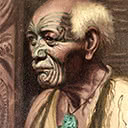Harata Rewiri Tarapata
22 x 17.5 cm
est. $50,000 - 80,000
PROVENANCE
Private Collection Auckland Webb's Fine Art, 07/12/2004
ILLUSTRATED
Plate I, p. 213 C F Goldie: Prints, Drawings & Criticism, Alister Taylor and Jan Glen, 1979
EXHIBITED:
J A Gibb, 105 Cashell Street, Christchurch, Fine Art Department, Picture Framer Art Dealer, 1906
Harata Rewiri Tarapata, widow of the late Chief Paul of Orakei. Harata (Charlotte) Rewiri Tarapata was the high born descendant of two noted chiefs, Tamati Waaka Nene and Eru Patuone, both early signatories of the 1840 Treaty of Waitangi. She was the daughter of Te Wharerahi of the Hokianga. Harata married Paora Tuhaere, a paramount chief of the Ngati Whatua tribe of Orakei, Auckland since 1868. Her husband had become a Christian early in life, taking the baptismal name of Paora (Paul). He was active as an Anglican lay preacher in hapu and intertribal gatherings, always preaching tolerance and peace. Paora Tuahere was the author of valuable historical accounts of Ngati Whatua history and historical narratives concerning their conquest of Kaipara and Tamaki.
Harata was his second wife, and together they had a daughter, Mere. In her youth Harata was acknowledged as a great beauty and became a familiar figure around the Orakei area. As a teenager she had delivered ammunition to Ngāpuhi warriors at Ruapekapeka (1845-46) and other key battles of the New Zealand Wars.
In maturity, Harata Rewiri Tarapata became a woman of great mana and was painted on several occasions by Charles Frederick Goldie and his leading pupil, Vera Cummings. Goldie's major work of this subject titled The Widow was painted in 1903 and is held in the collection of Te Papa Tongarewa.
Charles Frederick Goldie is primarily known as a painter with little attention paid to his drawing skill. Unlike other artist's, Goldie made very few preparatory studies for his paintings. However, an oil portrait featuring Harata Rewiri Tarapata and titled Suspicion was exhibited at the Auckland Society of Arts the same year as the present conte work. Suspicion is held in a Private Collection.
Another oil painting, also completed in 1906 carried the title Portrait of Harata Rewiri Tarapata. All three works are illustrated p. 212 C F Goldie: Prints, Drawings & Criticism, Alister Taylor and Jan Glen, 1979.
Harata Rewiri Tarapata is also the subject of one of Goldie's most famous paintings The Widow, 1903, sold by International Art Centre to the former National Gallery in 1991. It is now held in the Collection of Museum of New Zealand Te Papa Tongarewa. In this version, Te Papa refer her as He wahine mana nui e whakaatuhia ana hei pouaru matapōuri. A woman with great mana [authority], depicted as a sorrowful widow.





